| Report Type | Full |
| Peak(s) |
Lone Eagle Peak - 11,960' |
| Date Posted | 07/22/2025 |
| Date Climbed | 07/19/2025 |
| Author | kempenjn |
| Additional Members | aksean22 |
| Lone Eagle Peak via the North Face route (5.7) |
|---|
|
Sean: "Where's the fee station?" This trip report will detail the ascent of the North Face of Lone Eagle Peak, essentially following the pitch descriptions on Mountain Project. The Rack:
Boots on the ground at 3:33AM, a well-traveled trail takes us gently up the Cascade Creek drainage. 
Take the opportunity here (and along the way) to make some mental notes of the route ahead. From this vantage point, you can see a little over half of the route, around Pitch 5 the route disappears behind a buttress in the foreground, after Pitch 8 you will emerge and have great views of Crater Lake from above. 
Take the opportunity here (and along the way) to make some mental notes of the route ahead. You are aiming for the black streaks right in the middle of the North Face, then the steep diagonal ramp of trees. 
There is a network of trail around Mirror and Crater Lakes, we took the trail on the west side of Mirror Lake and quickly crossed a log jam to approach the east flank of Crater Lake. Faint trails took us generally south and east until we stood beneath the talus field on the Northwest slopes of Lone Eagle Peak. There we spotted a very well-defined climbers' trail and some fantastic wildflowers. 
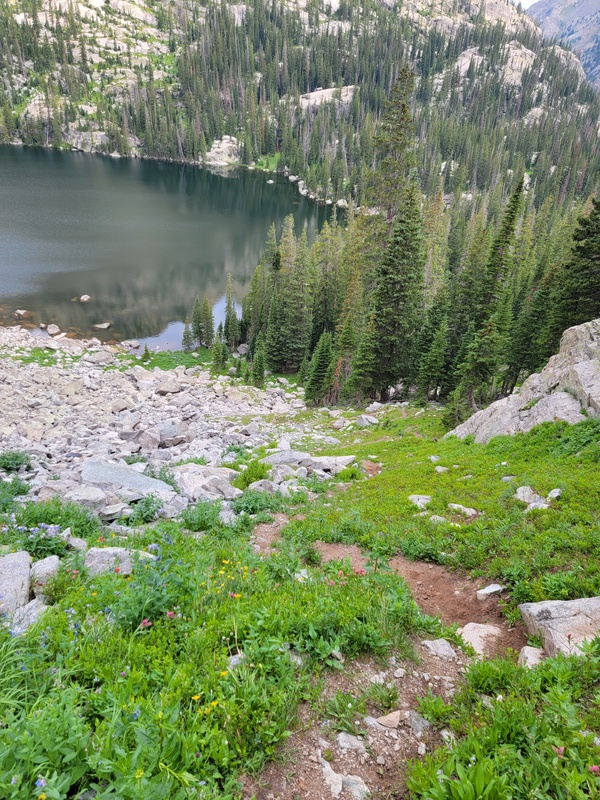

Follow the climbers' trail up the hill and crest the ridge, the black streaks of Pitch 1 will show themselves after long, but don't get suckered into going up the wrong one. Reference the photos. Despite our best efforts to be the first party on the route, we encountered the last member of a party of 3 at the base of Pitch 1. They camped at Crater Lake and had planned to be two parties of 2, but their fourth member got sick. Nice & friendly folks, forgot to get their names! 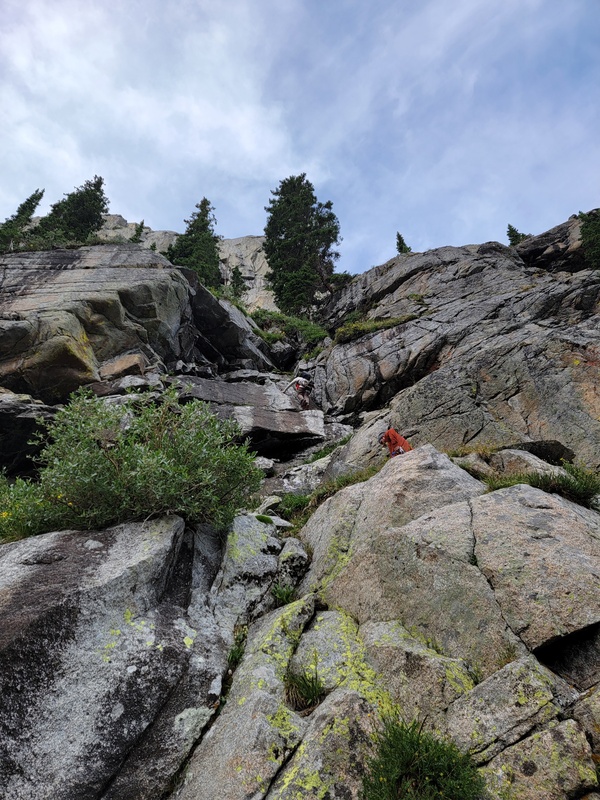
Pitch 1 is short and is a reasonable solo, especially if you are tall enough to reach the jugs - I am just about 6' and made it work. The crux is two moves off the ground, so it should be safe to investigate. Roping up here would be very reasonable. 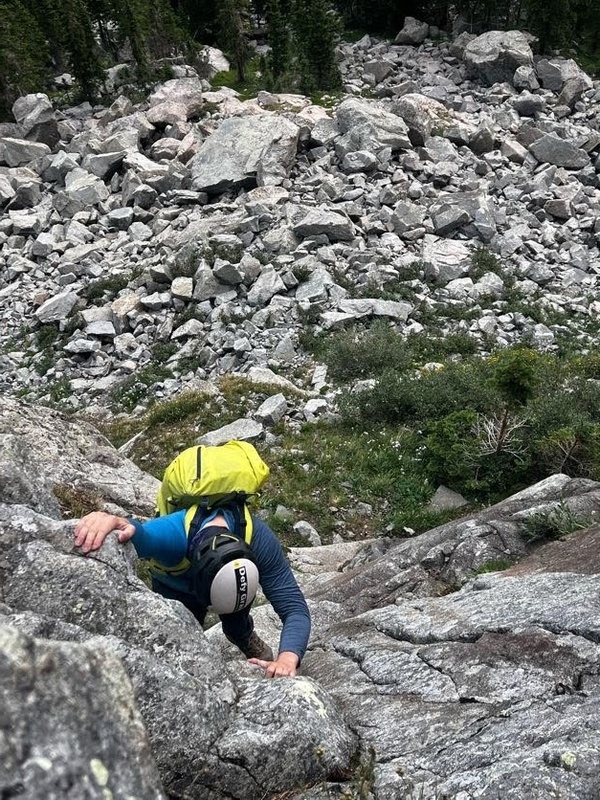
Pitch 1 deposits you on a large ledge with trees. Head uphill to the left to begin Pitch 2. Some rock protection is available but there are plenty of solid trees to sling, if roping up for these pitches. 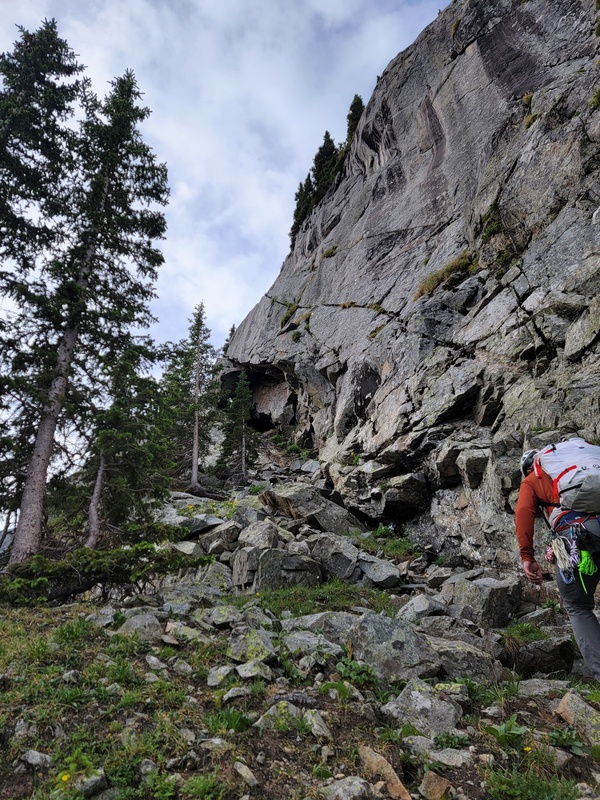
Hug close to the wall and you should feel very comfortable until the bouldery crux. 
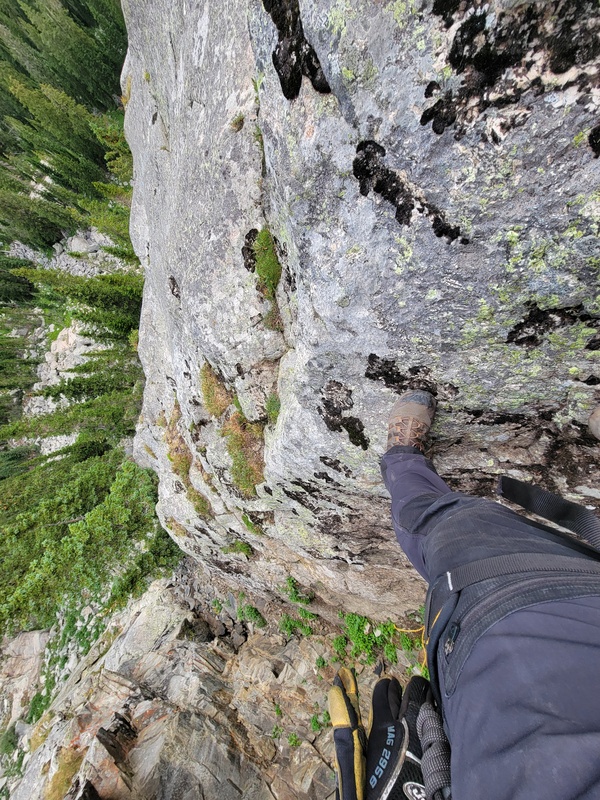
After the bouldery crux, ascend another steep treed ramp. 

You have one more boulder to surmount before the ledge peters out at P5. We caught up to the last member of the party of 3, who radioed ahead and spoke with his belayer who gave us permission to climb through their party, which was greatly appreciated. 
This last crux was slightly harder than the one before, but still had plenty of holds to make it work. 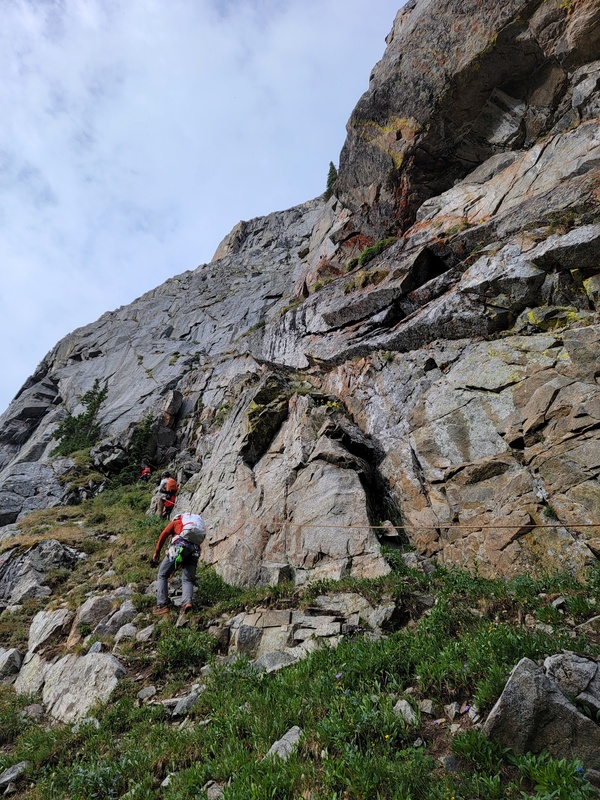
By this time we caught up with the leader of the party in front of us and made the decision to continue up P5 unroped. Pitch 5 is a collection of broken ledges with a short, wide chimney that fluctuates between 4th and low 5th class. 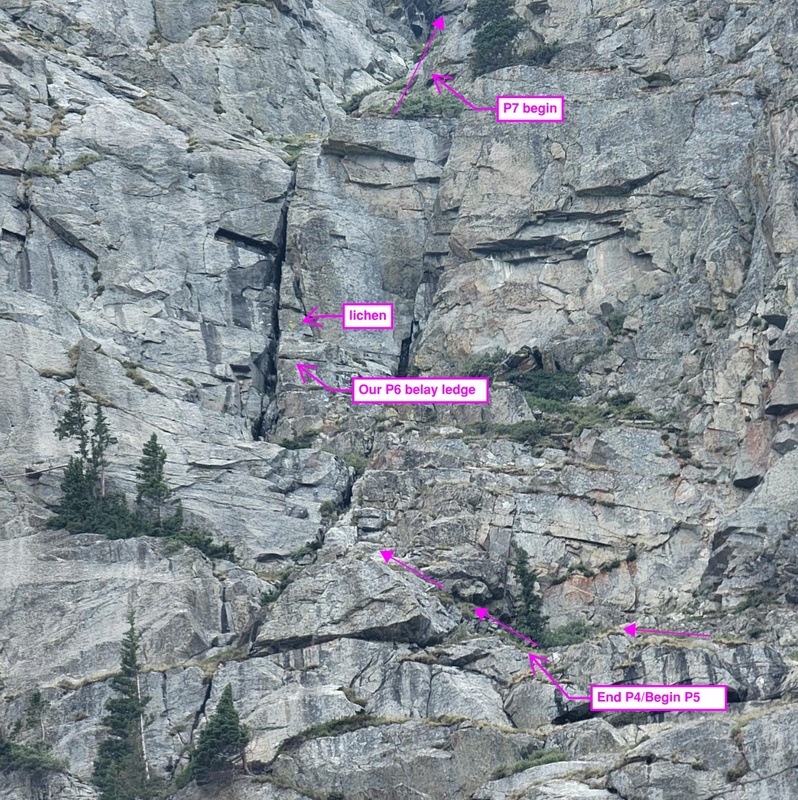
I am not 100% certain on the topo above, we may have gone more "directly up", but the perspective of the photo can be deceiving, a lot of depth is lost. After referencing Brian Yarian's excellent trip report, it seems like we soloed a portion of P6 before stopping to belay near the crux. 

The easy climbing abruptly comes to an end and the chimney gets tight. You should find a spacious sloping ledge to the bottom right of the tight chimney. By the lichen streak, a 0.75 or 1 camalot should work fine. 
Sean had a heck of a time leading this pitch due to his backpack getting in the way, something we had both read in trip reports and decided didn't apply to us. But he powered through with no falls and built a belay a ways above the top of the chimney before he found good rock. This pitch was pretty sweet, and punishing if you didn't have the proper technique (which I didn't, but I was on toprope!) After P6 we hiked up more grassy slopes and slipped back into our trail runners for pitches 7 and 8. 
After a short hike we were at the base of the first bulge of Pitch 7, we opted to go up the right side of the formation, which was less steep than the left side and had plenty of positive holds. 
There were a few more nondescript steep slabs along the way. 
We quickly came upon the crux headwall of P8, which was taller and steeper than those before it. The left side looked like it would protect well with rock pro, but the middle and right looked more friendly. The right side gets very steep 3/4 of the way up, then again, so does the middle... 
We ended up ascending a few moves up the right side, traversing to the middle, moving up a few more moves, then traversing up and back right, following a system of flakes. This section felt more like a boulder problem, if it's wet at all, I would say rope up and wear rock shoes. 

After this headwall, a few more grassy slabs led us to a notch and a massive ledge where we began our approach towards the crux P10. I went on belay just before 10AM. 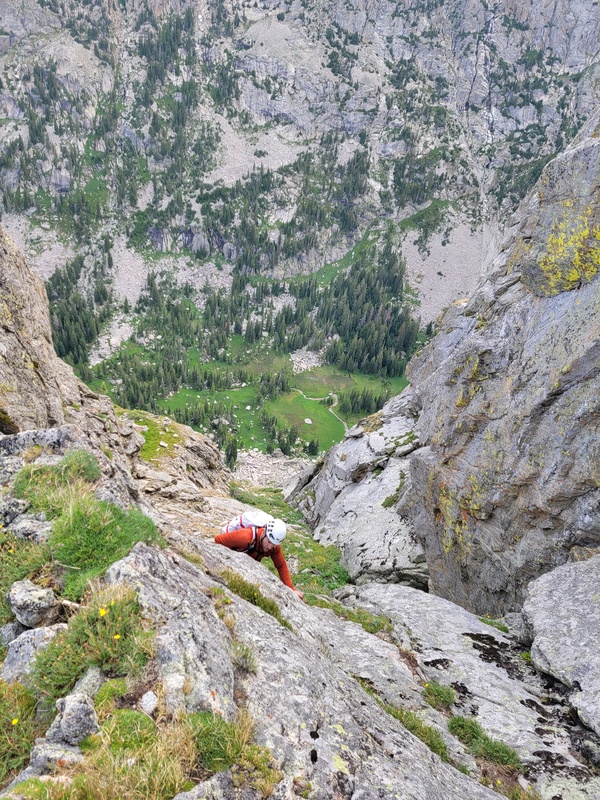
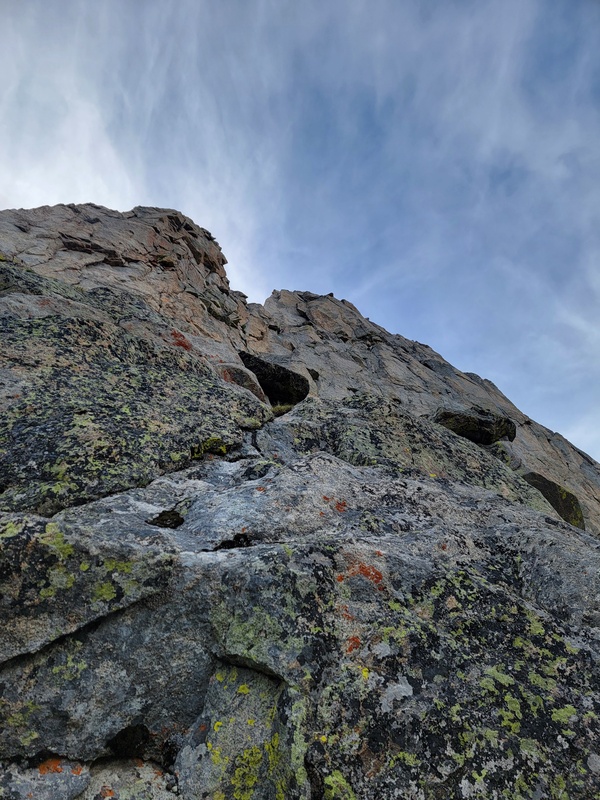
Pitch 10 is striking and deceiving. It doesn't look like it's actually 150' from the ground but it is. You begin by questing down and right to get established in the flake/crack system. I must have been 25 feet out before I got my first solid piece in. There are many placements down low but I had fears that they would break the flake if I fell on them. I took my sweet time, placing gear every 10' or so, which felt good to me since larger falls would have my rope sawing on the flake. I think I was on lead for one hour, practically crawling my way up one move at a time. At one point, after the crack came to an end, I had a completely hands-free sitting rest from which I could see my next few moves, a wide dihedral into a slab traverse. I could also see a chewed up sling that someone used to bail from the exact spot I was sitting. Nice. After a few minutes of doing absolutely nothing I had to make a decision. I placed another nut with a locker and cast off into the traverse, which had much better hands than I anticipated. Another piece placed and a short climb over a bulge led me to a gravely ledge behind a horn/spike feature that I planned to use as a belay, but was unfortunately loose. I made an anchor in the thin crack system in the back of the ledge and ended up with a single #2 left on my harness. I had placed 15 pieces of pro on the crux pitch and I was still 15 feet below the traditional end of the pitch. I brought a full double rack from 0.4-2 plus a #3 and a small rack of nuts and a few Aliens. I can't argue with the grade of 5.7, there were plenty of great jams and positive flakes, but the exposure felt enormous. Much more of a mental crux than anything else. Also there were a good number of prickly plants, watch where you put your hands! 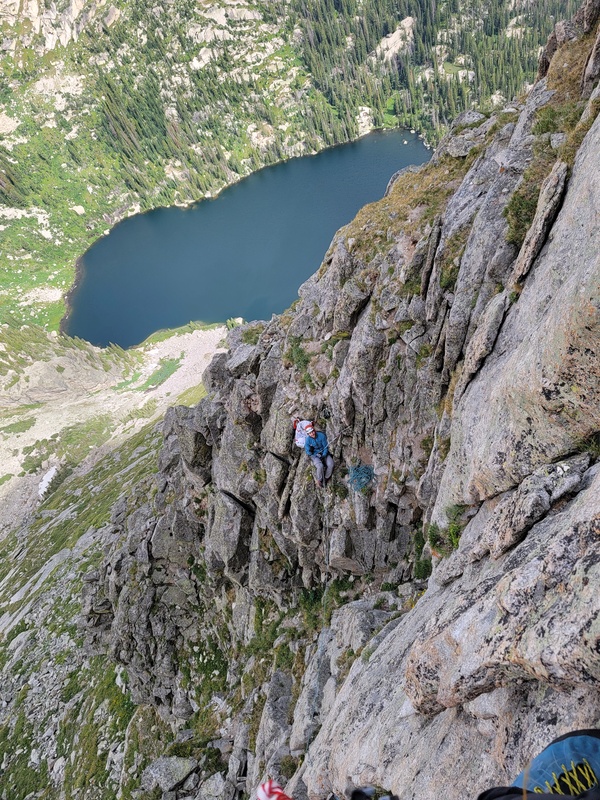

I was relieved to get off the sharp end and let Sean take over. By this time (11AM), our friends had caught up to us and were waiting their turn to get on the crux. 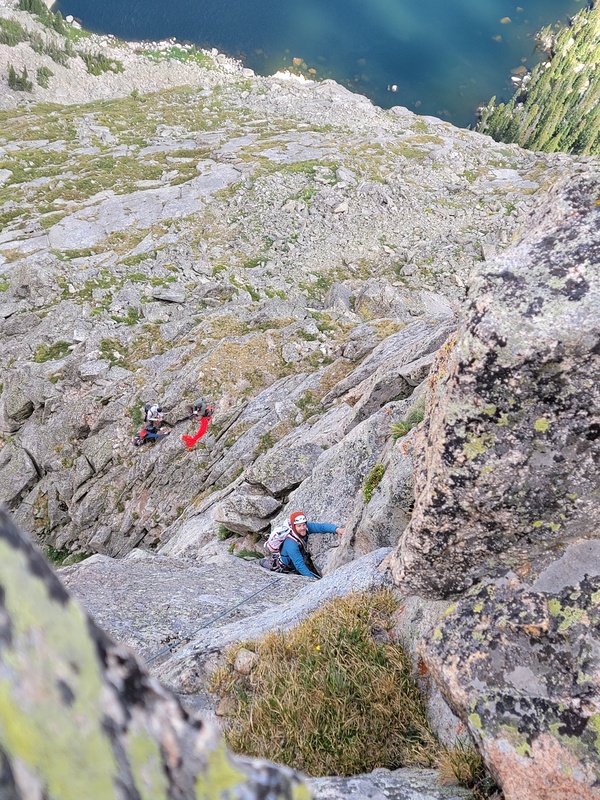


After reaching me at the belay, Sean continued on until he could make an anchor at what he believed was the summit chimney. "Left leaning 5.4 corner/chimney" - looked right to me! 
After looking back at some other trip reports, I see folks climbing a similar, but different corner system. The path we took ended up getting rather vertical and definitely harder than 5.4. We took the very dark corner in the center of this photo, just left of the direct 5.8 finish. I think we should have gone further left, but it doesn't really matter. It seems like "choose your own adventure" as far as the summit pitch goes. 

We ended up having bad rope drag so Sean set up another intermediate belay in an alcove maybe 25' below the summit (visible in the mtn project linked binocular photo above), so I followed and then led up a steep ramp on the east side of the summit. 
We summited exactly at 1PM, took in the views, packed up the rope, and set off to descend via Solo Flight. 


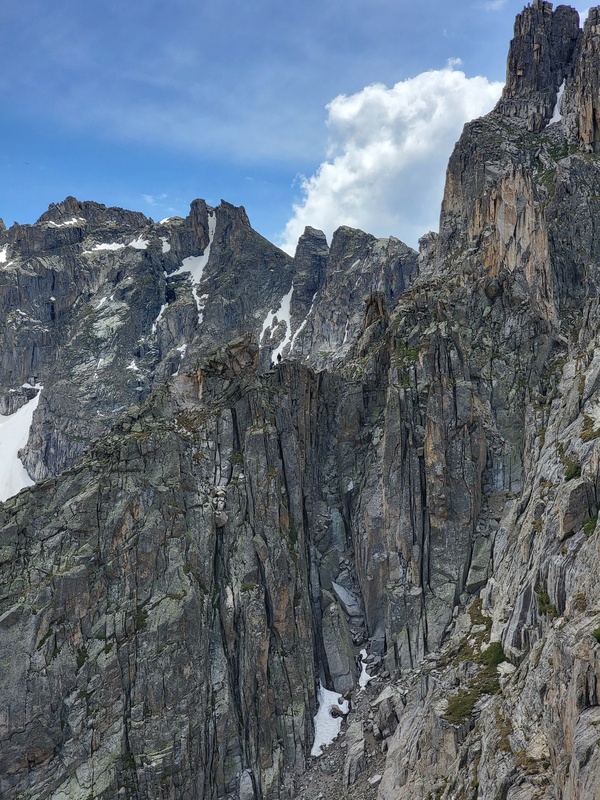
As for navigating our way backwards on Solo Flight, we generally thought the route followed an intuitive path down a series of flakes on grassy ledges. Eventually we noticed a generous series of cairns that helped us when things got confusing. 
After we downclimbed to a point where we were around eye-level with the "nope" gully, we traversed for a good bit until I looked up and noticed what looked like maybe 40'-50' of class 4 ledges that I could see connected the upper tier of rock with the top of the gully, so we could avoid climbing the very loose rock in the gully. There are a few ways to climb this section, follow your intuition and just go up! 
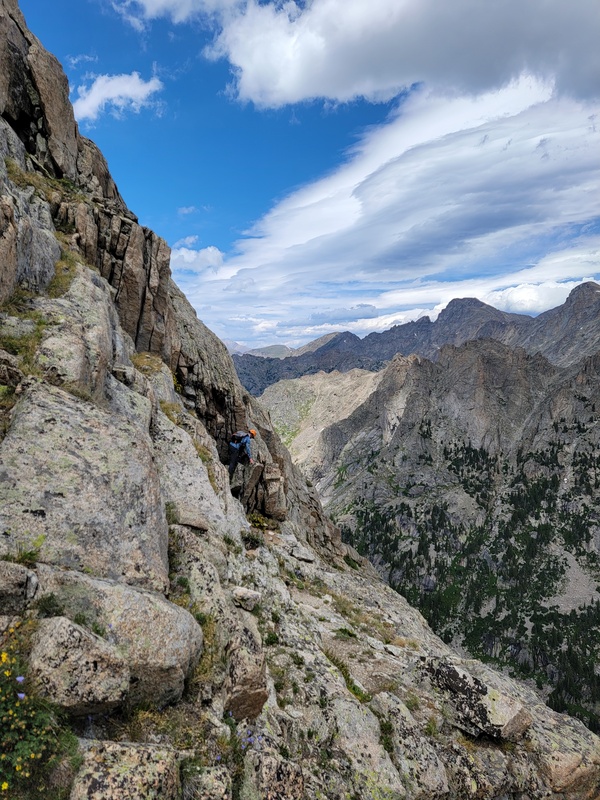
After the up-climb, we simply followed cairns through the very large notch and found ourselves staring down at Triangle Lake. 


We hadn't fully researched the lower portion of Solo Flight, instead defaulting to the route on mountain project here: https://www.mountainproject.com/approach-trail/113553649 See the discussion on that page, it's not the most efficient way down. This route ended up taking forever, descending all the way to Triangle Lake and making a very wide berth around Lone Eagle, with lots of boulder hopping and eventually bog-hopping. I have many pictures of this descent but I will defer to other trip reports specific to Solo Flight since we took the "wrong" way. Although we were pleasantly surprised to see a pair of moose munching on some dinner. 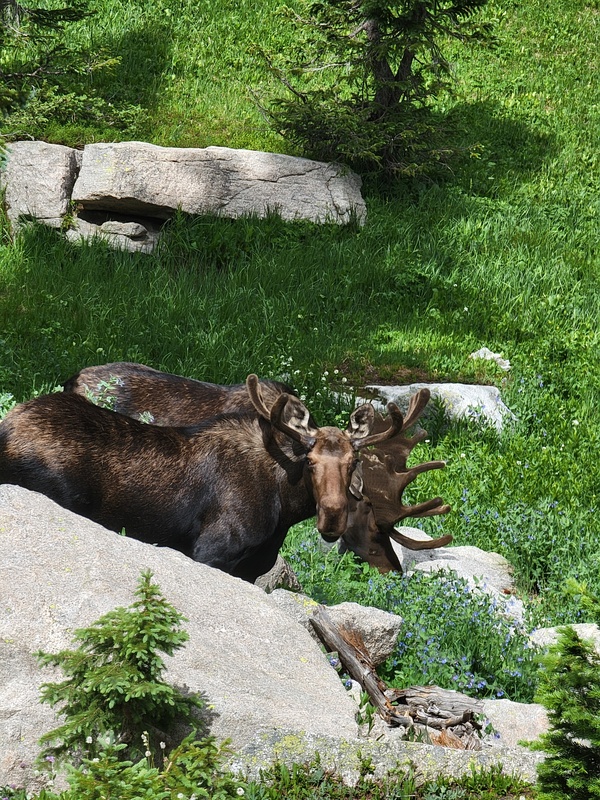
I kept looking back up at Lone Eagle as we rounded the peak, getting new perspectives on the route. 
We eventually saw the party of 3 up there around 3:30PM. 
After negotiating the bog and getting back on trail, we collapsed next to the river and drank ourselves sick on water. Then, as the evening rush of backpackers came up to stay the night at Crater Lake, we said our goodbyes, put our heads down, and boogied back to the cars by 7PM. Long day. Final Thoughts I highly suggest this route to anyone who doesn't mind a long hike (19/20 mi) and is okay with most of the climbing being spent on 3rd/4th class terrain with just enough 5th class to keep things really exciting. Besides Pitches 6 and 10, you can sit and rest almost anywhere on the route. I would not suggest this as anyone's first 5.7 trad lead, and would say that after the first few pitches, bailing would be an endeavor. Read all the trip reports, study the photos, comments, mountain project threads, etc. and you should be fine. If anyone wants more detailed beta/high-res photos, I have a ton, just PM me. This is one of the coolest places I've had the pleasure of visiting in my life, especially earlier in the summer with more runoff - I lost track of how many waterfalls there were in the upper cirque. Thank you, Sean, for coming, even though it isn't a bicentennial! 
|
| Comments or Questions |
|---|
|
|
Caution: The information contained in this report may not be accurate and should not be the only resource used in preparation for your climb. Failure to have the necessary experience, physical conditioning, supplies or equipment can result in injury or death. 14ers.com and the author(s) of this report provide no warranties, either express or implied, that the information provided is accurate or reliable. By using the information provided, you agree to indemnify and hold harmless 14ers.com and the report author(s) with respect to any claims and demands against them, including any attorney fees and expenses. Please read the 14ers.com Safety and Disclaimer pages for more information.
Please respect private property: 14ers.com supports the rights of private landowners to determine how and by whom their land will be used. In Colorado, it is your responsibility to determine if land is private and to obtain the appropriate permission before entering the property.
